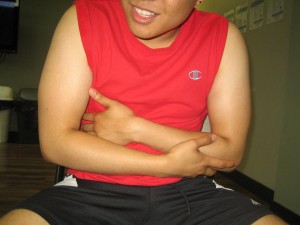Excess abdominal gas among children or commonly called as flatulence is quite common and typically easy to cure. The gas is primarily composed of odorless vapors including nitrogen, carbon dioxide, hydrogen, oxygen and oftentimes, methane. Excess amount of gas that was not passed out can lead to abdominal pain. There are some measures that can help minimize gas and relieve pain among children. If you want to learn ways to relieve the discomfort, click here.
Causes
There are three main causes of abdominal gas among children – eating gas-producing foods, swallowing air and certain diseases that disrupt with the absorption of sugar. Children swallow excess air when sucking their thumb, chewing gum or if they suffer from nasal allergies.
Certain foods such as beans produce gas in the large bowel. Those who are lactose intolerant can experience abdominal gas. In addition, intolerance to certain food sugars or diseases such as celiac disease and short bowel syndrome can cause excess flatulence.

Types
It is important to note that abdominal gas among children can be triggered by an organic condition which simply means that it is triggered by an identifiable issue or it can be caused by a functional problem which has no identifiable cause.
These organic disorders include heartburn, constipation, ulcers as well as and bone or muscle pain. As for functional disorders, there is no recognizable cause and typically include functional dyspepsia and irritable bowel syndrome (IBS).
What are the symptoms?
The symptoms of excess abdominal gas among children include abdominal pain and cramping, increased gas passage, bloating, diarrhea and constipation. Take note that gas can end up trapped in the bends of the colon, beneath the liver and in the region beneath the spleen, thus causing tenderness and pain in these areas.
These symptoms will keep the child awake at night. It is best to consult a doctor if the pain persists for more than a week and if the child starts to lose weight, vomits, has fever, stiff to the touch and if there is blood present in the stool or vomit of the child.
Treatment
There are various methods for treating abdominal gas among children. Primarily, avoid foods that can worsen the gas such as whole grains, dairy products, carbonated beverages and certain vegetables and fruits.
Chewing peppermint leaf can also help reduce the gas. Even over-the-counter medications that contain activated charcoal, simethicone or bismuth subsalicylate can help reduce the gas.
Considerations to bear in mind
In case the child has excess abdominal gas, there are various ways to help manage the condition. Parents should teach the child to release gas in a manner that is socially acceptable, such as leaving the room or going to the bathroom.
The intake of carbonated beverages or beans should be minimized. Food or beverages that contain lactose should be avoided if the child is lactose intolerant. Additionally, deodorizing products such as underwear made out of carbon fiber as well as cushions lined with charcoal can help minimize the smell of the gas.
